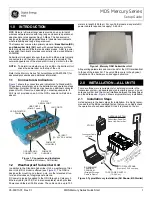
Upgraded-
8
Listening Modes
Mono
This mode is for playing old movies whose sound is
recorded in monaural or playing left and right channels
separately in the movies which contains the different
language signals recorded into individual channels. This
mode also allows you to listen to the multiplexed
soundtracks on DVDs, and other media that have them.
Direct
This mode delivers pure sound with minimum sound
quality adjustment and filtration. The sound recorded for
the right and left front channels is output to the right and
left front speakers only and not output to the subwoofer.
Stereo
This mode has all input sound is output from the left and
right front speakers.
Subwoofer also can be used for playback.
T-D (Theater-Dimensional)
For the best enjoyment of your home theater, it is
recommended that you have at least front left and right
speakers, a center speaker, and surround left and right
speakers. However, if you only have front left and right
speakers, you can enjoy multichannel audio by using this
mode.
This mode controls the characteristics of the sound that
reaches each ear to reproduce a multi-speaker setup. To
receive the full effect, there is an optimum listening
position (sweet spot). Refer to the explanation of the
listening angle. In addition, if the reflective sound
components are large, it may be difficult to achieve the
desired result, so be sure to set up your system and
listening position to minimize reflective sound.
Dolby D (Dolby Digital)
The Dolby D mode is used to play Dolby Digital sources.
• Dolby Digital EX
Enabled when playing back sources with surround
tracks that were encoded using the Surround EX
technology.
• Dolby EX
Select to achieve the same effects as Dolby Digital EX
encoded sources with non-Dolby Digital sources.
DTS
The DTS mode is used to play DTS sources.
• DTS 96/24
Automatically changes to this mode when playing
back sources with surround tracks that were encoded
using the DTS 96/24 technology.
• DTS-ES Discrete 6.1
With the addition of the surround back channel, this new
format has all 6.1 channels recorded independently for a
completely digital format. Since all channels are
recorded independently, high-fidelity surround playback
with the increased feeling of a separated sound space is
achieved.
• DTS-ES Matrix 6.1
This format has the surround back channel matrix
encoded and inserted into the left and right surround
channels so that at playback the output for the left,
right, and back surround channels are decoded using
a high-precision matrix decoder.
MPEG Multi (MPEG Multichannel)
Used for playing MPEG multi channel source.
AL
DOLBY DIGIT
Input Setup
Input source signals
a. Analog/PCM
Analog sources consist of LP records, FM and AM
broadcasts, cassette tapes, and the such. PCM (Pulse
Code Modulation) is one form of digital audio signals and
is recorded directly onto compact discs and DVDs
without compression.
b. PCM fs > 48 k
Digital PCM sources that are recorded at a sampling rate
of greater than 48 kilohertz. This includes DVDs that are
recorded with high quality audio.
c. PCM fs = 192 k
Digital PCM sources that are recorded at a sampling rate
of 192 kilohertz. This includes DVDs that are recorded with
extremely high quality audio.
d. Dolby D (Dolby Digital)
Digital data with AC-3 compression and a maximum of
5.1-channel surround sound. This source signal comes
from DVDs and LDs that have the
mark and
therefore recorded for 5.1-channel output.
Dial norm
Dialogue Normalization (Dial Norm) is feature of Dolby
Digital. When playing back software that has been
encoded in Dolby Digital, sometimes you may see a
brief message in the front panel display that read Dial
Norm xdB (“x” being a numeric value). Dialogue
Normalization serves to let you know if the source
material has been recorded at a higher or lower level
than usual. For example, if you see the message “Dial
Norm: +4” in the front panel display, to keep the
overall output level constant just turn down the
volume control by 4 dB. In other words, the source
material that you are listening to has been recorded 4
dB louder than usual. If you do not see a message,
then no adjustment of the volume control is
necessary.
e. DTS
DTS (Digital Theater System) is compressed digital data
with a maximum 6.1-channel surround output that allows
for an extremely high-quality sound. This source signal
requires a DVD player that supports DTS output and
comes from DVDs, compact discs, and LDs that have the
mark.
f. MPEG Multi
Digital data with a maximum of 5.1-channel surround
audio with MPEG compression. This source signal comes
from DVDs that have the
mark.
g. D.F. 2 ch (Digital Format 2 channel)
2 channel digital signal (except for PCM) such as Dolby
Digital. DVD or LD in which the 2 channel sound are
recorded may be this type of input signal.
h. D.F. Mono (Digital Format Monaural)
Monaural digital signal (except for PCM) such as Dolby
Digital. DVD or LD in which the monaural sound are
recorded may be this type of input signal.









































